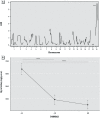Genome-Wide Association Study to Identify Genes Related to Renal Mercury Concentrations in Mice
- PMID: 26942574
- PMCID: PMC4937848
- DOI: 10.1289/ehp.1409284
Genome-Wide Association Study to Identify Genes Related to Renal Mercury Concentrations in Mice
Abstract
Background: Following human mercury (Hg) exposure, the metal accumulates in considerable concentrations in kidney, liver, and brain. Although the toxicokinetics of Hg have been studied extensively, factors responsible for interindividual variation in humans are largely unknown. Differences in accumulation of renal Hg between inbred mouse strains suggest a genetic interstrain variation regulating retention or/and excretion of Hg. A.SW, DBA/2 and BALB/C mouse strains accumulate higher amounts of Hg than B10.S.
Objectives: We aimed to find candidate genes associated with regulation of renal Hg concentrations.
Methods: A.SW, B10.S and their F1 and F2 offspring were exposed for 6 weeks to 2.0 mg Hg/L drinking water. Genotyping with microsatellites was conducted on 84 F2 mice for genome-wide scanning with ion pair reverse-phase high-performance liquid chromatography (IP RP HPLC). Quantitative trait loci (QTL) were established. Denaturing HPLC was used to detect single nucleotide polymorphisms for haplotyping and fine mapping in 184 and 32 F2 mice, respectively. Candidate genes (Pprc1, Btrc and Nfkb2) verified by fine mapping and QTL were further investigated by real-time polymerase chain reaction. Genes enhanced by Pprc1 (Nrf1 and Nrf2) were included for gene expression analysis.
Results: Renal Hg concentrations differed significantly between A.SW and B10.S mice and between males and females within each strain. QTL analysis showed a peak logarithm of odds ratio score 5.78 on chromosome 19 (p = 0.002). Haplotype and fine mapping associated the Hg accumulation with Pprc1, which encodes PGC-1-related coactivator (PRC), a coactivator for proteins involved in detoxification. Pprc1 and two genes coactivated by Pprc1 (Nrf1 and Nrf2) had significantly lower gene expression in the A.SW strain than in the B10.S strain.
Conclusions: This study supports Pprc1 as a key regulator for renal Hg excretion.
Citation: Alkaissi H, Ekstrand J, Jawad A, Nielsen JB, Havarinasab S, Soderkvist P, Hultman P. 2016. Genome-wide association study to identify genes related to renal mercury concentrations in mice. Environ Health Perspect 124:920-926; http://dx.doi.org/10.1289/ehp.1409284.
Conflict of interest statement
The authors declare they have no actual or potential competing financial interests.
Figures





Similar articles
-
Bank1 and NF-kappaB as key regulators in anti-nucleolar antibody development.PLoS One. 2018 Jul 17;13(7):e0199979. doi: 10.1371/journal.pone.0199979. eCollection 2018. PLoS One. 2018. PMID: 30016332 Free PMC article.
-
The effect of toxicokinetics on murine mercury-induced autoimmunity.Environ Res. 1998 May;77(2):141-8. doi: 10.1006/enrs.1998.3833. Environ Res. 1998. PMID: 9600807
-
Mercury toxicokinetics--dependency on strain and gender.Toxicol Appl Pharmacol. 2010 Mar 15;243(3):283-91. doi: 10.1016/j.taap.2009.08.026. Epub 2009 Sep 2. Toxicol Appl Pharmacol. 2010. PMID: 19732784
-
QTL mapping using high-throughput sequencing.Methods Mol Biol. 2015;1284:257-85. doi: 10.1007/978-1-4939-2444-8_13. Methods Mol Biol. 2015. PMID: 25757777 Review.
-
The relevance of the individual genetic background for the toxicokinetics of two significant neurodevelopmental toxicants: mercury and lead.Mutat Res. 2010 Oct;705(2):130-140. doi: 10.1016/j.mrrev.2010.06.003. Epub 2010 Jun 30. Mutat Res. 2010. PMID: 20601101 Review.
Cited by
-
Bank1 and NF-kappaB as key regulators in anti-nucleolar antibody development.PLoS One. 2018 Jul 17;13(7):e0199979. doi: 10.1371/journal.pone.0199979. eCollection 2018. PLoS One. 2018. PMID: 30016332 Free PMC article.
-
In silico mapping of quantitative trait loci (QTL) regulating the milk ionome in mice identifies a milk iron locus on chromosome 1.Mamm Genome. 2018 Oct;29(9-10):632-655. doi: 10.1007/s00335-018-9762-7. Epub 2018 Aug 2. Mamm Genome. 2018. PMID: 30073618
References
-
- Akesson I, Schutz A, Attewell R, Skerfving S, Glantz PO. Status of mercury and selenium in dental personnel: impact of amalgam work and own fillings. Arch Environ Health. 1991;46:102–109. - PubMed
-
- Andersen CL, Jensen JL, Ørntoft TF. Normalization of real-time quantitative reverse transcription-PCR data: a model-based variance estimation approach to identify genes suited for normalization, applied to bladder and colon cancer data sets. Cancer Res. 2004;64:5245–5250. - PubMed
Publication types
MeSH terms
Substances
LinkOut - more resources
Full Text Sources
Other Literature Sources
Medical
Molecular Biology Databases
Miscellaneous

